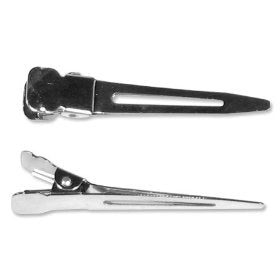Making Dreadlocks with the Spin & Pin Method
Popular names for this method:
Not to be confused with double or triple strand twists.
- Twist and pin
- Spin and pin
- Finger Twisting
- Comb coils
- Twist -or- Single Twist -or- Single Strand Twist
The Spin & Pin or twist and pin method is the most commonly used method for creating dreadlocks in highly textured hair. I'd also venture to say it produces the most delicate baby dreads of any method. While it's the simplest to do it's also the hardest to see though to finished dreadlocks. It only works in well in one hair type, highly textured African hair. Caucasians and Asians shouldn't even attempt this method. Many have however, and as many were more than a little upset with the locticians who confidently attempted it. There are a lot of variations of this method and a lot of names for those variations but in essence the unlocked hair is spun around and around in one direction. It may be secured in different ways but the hair is just twisted and the only thing holding it together is the texture of the hair and a small amount of cream.
The hair can all be sectioned and held with clips before the twisting begins to ensure that the sections are even and have the same amount of hair. Experienced locticians may just grab sections as they go instead of sectioning it a head of time. (Inexperienced locticians try this as well with mixed results) Because you can section the hair you have control over the size of the dreads you get. Larger sections grow larger dreads etc. The range of sizes that work in African hair is fantastic, from tiny nano-locs to huge rasta congos.
How long does the hair need to be for Spin & Pin locs?
It needs to be long enough that you can twist it together can clip it in place. Hair shorter than two inches will make twists that are a bit more delicate but it's still possible to get them started. Hair that is longer than 4" or 5" is better suited to other dreadlock methods like strand twists or backcombing.
Spin and Pin Step by Step
- 1. If you are sectioning the hair first use a comb or your fingers to section the hair. The larger the section the thicker the dreads. Keep sections square so dreads grow round, not flat. Secure the sections with a clip as you go.
- 2. Apply Knatty Dread cream to the hair and spin the lock to the right or "clockwise" until it us under enough tension to compress it and make it feel tight. Use enough cream to ensure that the entire length of the hair gets some. Beyond that, extra cream provides no additional benefit. Resist temptation to taste the Knatty Dread cream. (I know exactly how good it smells but you must resist.)
- 3. Use a hair clip or pin to hold the twist so it doesn’t unravel. Different clips work better depending on the length of the dreads but most will do fine as long as the dreads are held so they can't un-twist. Care should be used to avoid clips that are damaging to the hair/dreads. See pictures of popular clip styles at the bottom of this page.
- 4. Sit under a dryer or use a hair dryer to set the twists. This step is important. It is crucially important for larger dreads that will have difficulty drying otherwise. Take care not to over heat the hair as it will do more harm than good. Let it dry completely and sit for at least 3 hours if possible. If you are brave, you can cover the dreads and carefully sleep on the clips.
The quality of the loc cream used, your activity level and how rough you are with the dreads will determine how long the twists will stay tight. High activity level and sweating can cause twists to loosen. If these activities are part of your lifestyle cover your twists with a nylon cap that holds your twists securely. Rinse sweaty dreadlocks though a stocking as mentioned on the dreadlocks shampoo page. If you can find a loc cream that provides a longer lasting, fresher or tighter feeling than my Knatty Dread cream I want to know about it! For quite some time now I'm told I have a leg up on the competition! Give it a try and let me know what you think.
Why not twist counter clockwise or to the left?
Always doing it to the right will keep the direction consistent, is 90% of the reason. Clockwise is preferable to Counter-Clockwise because more people have circular growth patters that run in the clockwise direction. (Supposedly 70% of us) So this direction works with the natural direction of our hair.
These are popular clips for securing twists when starting or re-twisting dreadlocks.



